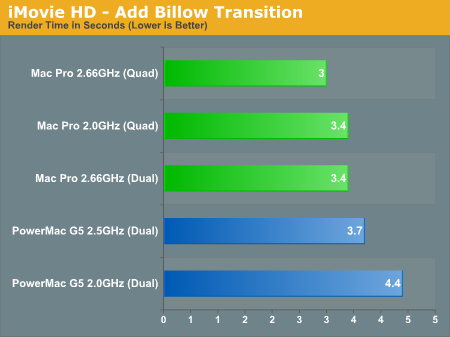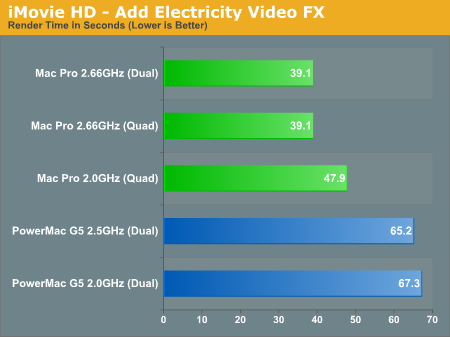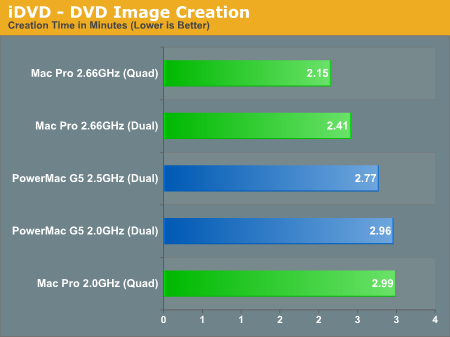Apple's Mac Pro - A True PowerMac Successor
by Anand Lal Shimpi on August 16, 2006 12:27 PM EST- Posted in
- Mac
iLife '06 Performance with iPhoto, iMovie HD and iDVD
One of the benefits of OS X and Apple's application suites is that most of the applications are already properly threaded. Even though you wouldn't expect it, iPhoto is threaded quite well and thus our import photos test gets a speedup from going to quad cores.
The test is simple; we timed the import of 379 photos into iPhoto which, believe it or not, is quite CPU intensive and not as I/O bound as you'd think. After we got the time we divided it into 379 to get the number of pictures imported per second. We included the performance of a hypothetical dual core Mac Pro in addition to the native quad offerings in order to provide a good point of comparison to the dual processor PowerMac G5s.

Although there's a slight performance boost when going from dual to quad core (6.9%), this test is largely dependent on clock speed within a single microprocessor architecture. Comparing the Woodcrest based Xeons to the older G5s is no contest, at 2.0GHz the Mac Pro is already 14% faster than the 2.5GHz PowerMac G5; even if we account for the dual vs. quad core comparison, the 2.0GHz Mac Pro is still noticeably faster than the G5.
The next application we looked at was iMovie HD. There are two primary focuses for performance in iMovie HD, video import speed (if you are dealing with a non-DV or non-iSight video source) and effect rendering speed. We focused on the latter, measuring the time it takes to render the most CPU intensive transition and video effect in iMovie HD.

Our Macs have gotten a little too fast for the billow transition test, as the Mac Pro 2.66GHz can now complete the test in 3 seconds flat. All of the Mac Pros here are faster than the PowerMac G5s, which is what we'd expect given what we learned in the iMac Core Duo vs. iMac G5 article.

Rendering the "Electricity" Video FX sees no benefit going from dual to quad cores, but the Mac Pro doesn't need it as the 2.0GHz configuration is already 26.5% faster than the PowerMac G5 2.5GHz.
Finally we've got iDVD, an application that you can use to create DVDs that are playable on any consumer DVD player. There are once again two aspects to performance in iDVD, video encoding performance and menu encoding performance. Since we've already looked at video encoding performance with Quicktime, this test is predominantly limited by how long it takes to encode the menu system in our test DVD. There is a small 13 second iSight video and audio that's encoded in the process but it adds a matter of seconds to the overall time. The image is written to disc instead of sent to the DVD burner for obvious reasons. The results are expressed in seconds, lower being better. This workload is multithreaded.

The benchmark gets just under 11% thanks to the 4 cores in the Mac Pro, but even without them the Mac Pro 2.66GHz is able to outperform the PowerMac G5 2.5GHz by just under 13%. The Xeon seems to scale much better with clock speed in this test than the G5.










96 Comments
View All Comments
spike spiegal - Thursday, August 17, 2006 - link
Question 1:Apple users have been bad mouthing Intel and PC's for over a decade and touting the superiority of Motorola, and then IBM over Intel. Now that Apple is running on nothing more than PC clone with an Apple bios and beating the heck out of the dual G5, isn't this a little hypocritical? When Apple switches to Cyrix next year, how much faster will those machine be over Intel?
Question 2:
If OSX so much more "secure", "faster" and "easier" to use than Windows or Linux, and OSX is closer to Unix than Liux is, why have I never encountered an Apple machine or OSX inside a corporate server farm? Are the graphics artists in the company media dept using Macs that much more intelligent than the network engineers who's job is on the line to keep commerce up 24/7?
Question 3:
A year from now when E-machine is selling boxes that cost half the price of the new PowerMac and has twice the horsepower because of new processors being introduce by either AMD or Intel, how can we fudge PowerMac benchmarks for the courtesy of Apple users?
Question 4:
I want to run OSX legally on my dual core AMD, and I don't want to buy a new computer just to run OSX. I can run Windows on any hardware I want...why not OSX?
plinden - Thursday, August 17, 2006 - link
Q1: Hmm, have you heard about the best tool for the job? G5s kept up well with Intel and AMD, and were often faster - sometimes much faster - but weren't going anywhere in the foreseeable future. Did you notice that that the new 2.66GHz Xeons aren't much faster than the 2.5GHz G5s they're replacing? But the potential is there for the future (the 3GHz Xeons show that). I don't know whether you're an AMD or Intel fanboi, but would you continue using a CPU from your current favourite manufacturer if you could foresee {AMD/Intel - delete as necessary} pulling well ahead? A computer is just a tool to get things done, what CPU is in there is a pointless argument, and your strawman argument just makes that all the more obvious.Q2. Hmm, have you heard about the best tool for the job? XServes are gaining some traction, especially in specialist areas, but I work a company that delivers streaming content on the internet, and we use (mostly) generic PCs running RedHat ES. We also have a number of Windows Media Servers for encoding wmv content and use Apple's Darwin QuickTime Streaming Server (running on Linux, incidentally). The fact that I actually enjoy doing my work with OS X, and find myself being more productive with desktop applications, doesn't mean that if I were making the buying decisions for my company, I would immediately insist on using XServes just because they're from Apple.
Q3: Cool, e-Machines are going to be producing 8-CPU Xeon-powered workstations for $1250? I might get a couple of those for the kids. Or maybe Apple might upgrade their offerings ... they've been known to do that occasionally.
Q4: Because Apple owns the rights to OS X, they make the decisions. If they offered OS X to run on any PC, I would be first in line to install it on my Dell laptop.
michael2k - Thursday, August 17, 2006 - link
1) At the time those comments were made, PPC was faster than Intel, literally. Then the IBM was faster than a P4, just like an Opteron was faster than a P4. You would be stupid to believe if Cyric made a faster, cheaper, cooler CPU that Apple wouldn't consider it.2) Why would a corporate SERVER FARM care about "secure", "faster", or "easier"? A SERVER FARM cares about redundancy, reliability, recovery, and distributed computing. The only places you will find a Mac are places that care about:
1) usability, say at a design firm
2) design, say at a advertising firm
3) ease, say at a home
Also, you do know that the pural for "anecdote" is not "data", right? Your anecdote only means you have limited experience.
3) Easy, drop in a new Intel processor.
4) Because no copy of OS X exists for generic x86 hardware. You also cannot run Windows on any hardware you want. Try to run it on an SGI MIPS workstation, an IBM PowerPC Workstation, a Dec Alpha workstation, or an Apple G4 iMac. This is despite the fact that Microsoft originally wrote Windows NT to support Alpha, MIPS, PowerPC, and Intel. You want to know why Apple won't produce generic OSes? Because they aren't big enough to afford the support and market costs. Until, I think, they hit 30% marketshare, they can't afford to sell their OS as a generic software kit.
saratoga - Thursday, August 17, 2006 - link
PPC was very rarely faster then x86. More often it was on par, but seldom faster, and usually only briefly. People went on and on about PPC performance because they had bought expensive PPC systems.Dubb - Thursday, August 17, 2006 - link
Really curious about those three:1) any issues with xp-64
2) We all know you have clovertons already. put them in and see what happens. then tell us.
3)Apple's price on a 4500 is way overpriced. there has to be a way to get a quadro 3500 working in one.
mgrimard - Thursday, August 17, 2006 - link
Since it is cheaper than a Dell, what about using as a server (with Windows Server 2003)?It is a server that it will most benefit from the quad-core and dual-gbe, don't you think?
Calin - Thursday, August 17, 2006 - link
"Of course if there's performance to be lost, we're there to benchmark it."That is very funny :)
And by the way, very nice article. Enjoyed every page of it. Thanks!
IntelUser2000 - Wednesday, August 16, 2006 - link
FB-DIMMs are not at complete fault here. It lies majorly in the memory controller. PC chipsets ALWAYS perform better than the workstation/server ones.
Calin - Thursday, August 17, 2006 - link
I find it strange that dual and quad channel FBDIMMs have the same memory read speed in Everest (or the difference is so small as not to be noticeable)dborod - Wednesday, August 16, 2006 - link
I understand the advantages of installing 4 FB-DIMMs vs. 2 FB-DIMMs and the need to install them in pairs, but does it matter if the first two pairs of FB-DIMMs are of difference sizes? In other words is 2 x 512 MB and 2 x 1 GB FB-DIMMs going to result is lower memory performance than 4 x 512 MB FB-DIMMs?